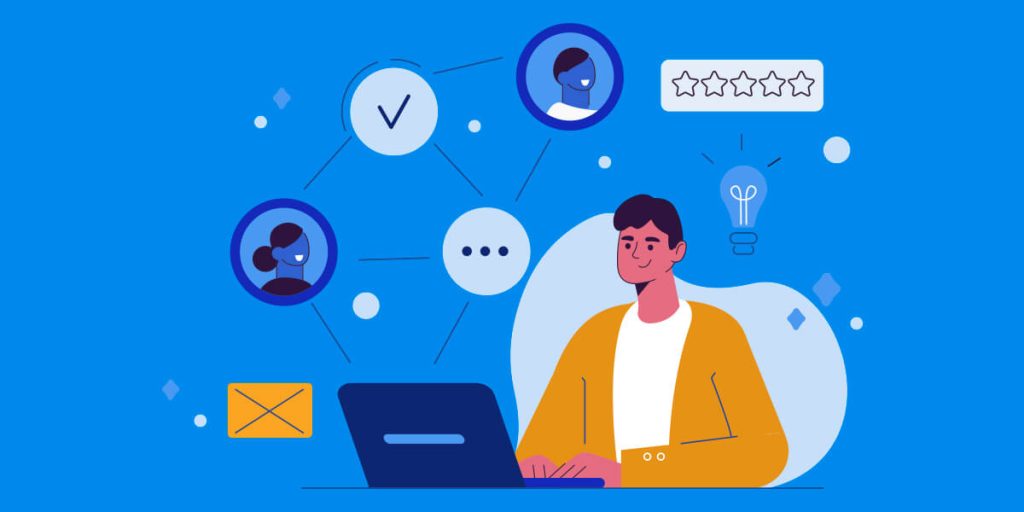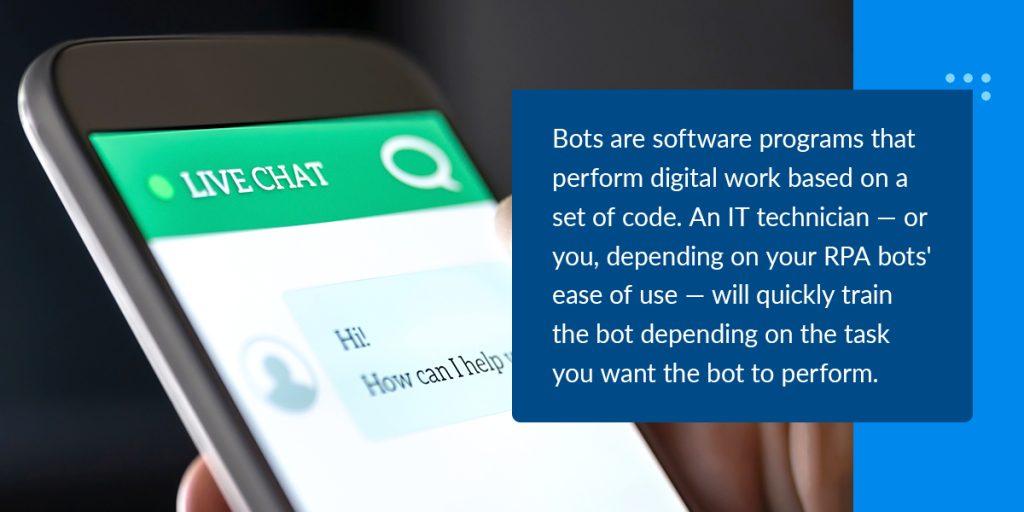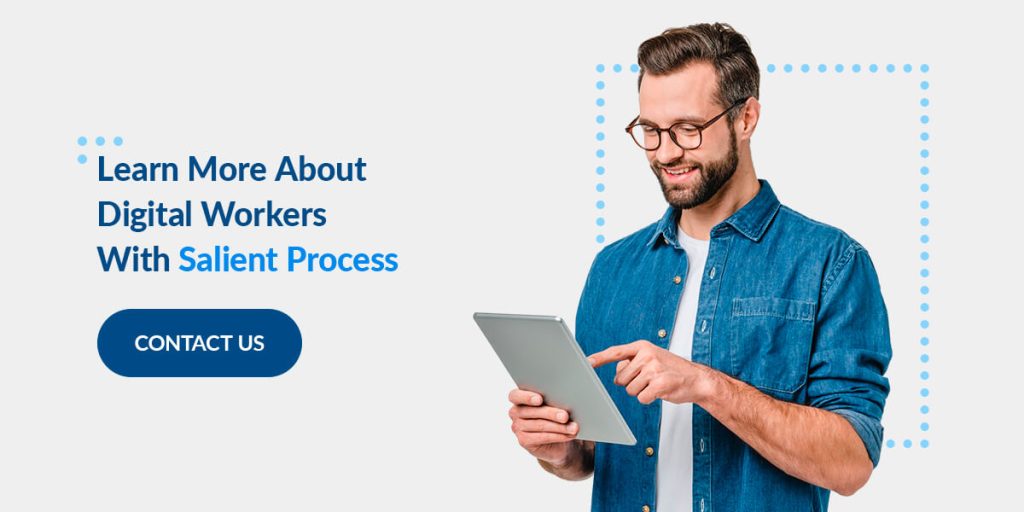
Every business relies on workers to succeed. Some processes may be more tedious than others, causing efficiency and employee morale to drop. As a result, you may be looking for a way to improve workflows and business functions throughout your company.
Business automation is one of the best ways to increase efficiency and reach your productivity goals. But with several types of automation available, which is best for your business? Read on to learn more about digital workers and how they differ from regular bots used in automation processes.
A digital worker combines artificial intelligence, robotic process automation, analytics and machine learning to automate end-to-end business functions. A digital worker’s primary purpose is to automate human efforts, increasing business process efficiency and freeing employees to do other tasks. Digital workers and human workers coexist to benefit your entire organization. Often, clients and consumers also profit due to this arrangement.
Today’s workplaces are undergoing a digital transformation across industries, and labor technology is one of the areas experiencing a renaissance. With a digital workforce to augment your human employees, you can experience many efficiency, productivity and analytics benefits to scale your business and reach new levels of success.

Though bots and digital workers are both means of achieving business automation, they differ in several pivotal ways. Bots like the ones used in robotic process automation focus on single tasks. One bot can perform its job as programmed with zero use of artificial intelligence to grow and adapt via machine learning. Examples of the tasks bots complete include reading documents, copying, pasting, sending emails, etc.
Unlike bots, digital workers perform start-to-finish business functions to augment human workers. While a bot can automate one task at a time, digital labor technology can enhance any job role thanks to its combination of machine learning, AI, RPA and analytics. Digital workers can perform more complex assignments that assist humans with their work in exciting ways.
While you may think a digital worker is merely an advanced bot, it’s crucial to distinguish the two terms because of their vast differences. Here are three abilities of a digital workforce that RPA bots can’t offer.
A digital worker can perform various tasks for your organization. The vast possibilities mean you can find the exact solution or solutions you’re looking for, depending on your organization’s unique needs and goals. Before looking at what digital workers can perform, here are a few processes that enable them to complete their duties:
Thanks to these abilities, they can perform many tasks that make work easier for human employees, including the following:
Repetitive responsibilities can reduce efficiency on the job for human employees. Handing them over to digital workers will free up your employees to focus on other, higher-value responsibilities.
If your company is looking to automate some of its processes, remember that the goal is to augment the work your human employees are already doing. Digital employees use state-of-the-art technology to learn, process information and perform tasks to simplify human workers’ jobs. Transitioning to a fully digital workforce may not be possible, as digital workers can’t handle some complex duties.
For all their advantages, bots and digital employees still cannot replicate the human touch. Humans can think outside the box, stay persistent during unique situations and offer tailored customer experiences. Often, clients prefer to deal directly with people instead of digital employees. As you incorporate digital employees into your organization, consider starting with tasks that don’t require imagination, so your human employees can flourish at the creative tasks they do best.
Let’s dig a little deeper into the notable differences between a digital worker and a bot. This understanding will help you see how they can fit into your business and which is better for your needs.

Bots are software programs that perform digital work based on a set of code. An IT technician — or you, depending on your RPA bots’ ease of use — will quickly train the bot depending on the task you want the bot to perform. These are often menial duties like those we’ve already mentioned, which may include copying documents, sending emails and compiling files.
The essential point to remember is that a bot can only perform one function based on the instructions in its code. Once set up, the bot can automate those menial, less creative tasks throughout your workforce.
Bots and digital workers have different abilities. While bots focus on automating one task at a time, digital workers can think, act and analyze situations to augment your human workers’ business processes. They learn and process information on the fly and often come as prebuilt, downloadable software that immediately starts assisting your team.
Digital workers can perform and automate much more involved, comprehensive tasks than bots. They can also evolve as they continue gathering data and learning about your business’ processes, making them a truly unique business automation solution to enhance workflows.
To fully grasp the difference between digital workers and bots, it helps to see a side-by-side comparison of their capabilities.
Here are some examples of suitable tasks for bots:
Here are some examples of jobs for digital workers:
There are many other ways to use digital workers to enhance your business. Salient Process is here if you have any questions to help you determine the best ways to implement digital workforce tasks.

Using digital worker technology will provide many benefits for your organization. Here are three notable benefits you and your team can enjoy.
A digital worker will provide immediate efficiency and productivity benefits to your business. That level of efficiency and productivity will only grow as you build your digital workforce throughout your company. As you augment more of your human workers with digital workers, your human employees will have more time to focus on the specialized skills where they excel.
When you strike an ideal balance of human and digital workers, your human employees can perform at peak efficiency and productivity. The digital workers will consistently provide the same high output level, so you can rest assured that your business meets its goals and key performance indicators.
Digital workers are immune to human error. They don’t get distracted or overlook things because they are tired, hungry or not feeling their best. They stay focused on their tasks. For this reason, many finance, health care and life science businesses use digital workers to maintain strict compliance standards and avoid hefty error-associated costs.
Digital workers also help lower costs by providing a fast return on your investment. Human workers will gain more time to focus on mission-critical responsibilities, which will immediately improve your bottom line. You’ll save more dollars every day while also improving your employees’ morale because of the regained time they get to use for more fulfilling tasks.
Digital workers naturally increase efficiency and productivity. They can’t get sick, have a flat tire on the way to work or waste time on the clock. They’re always completing responsibilities and learning from the data they gather. With consistent, round-the-clock performance, you’ll see an uptick in your company’s productivity thanks to your digital workforce’s 24-hour consistency.
Despite the many advantages of using a digital workforce to augment your human employees’ work, you must consider some possible downsides. Here are three potential disadvantages of using digital workers.
Digital workers take time and money to implement. The deployment process will take a different amount of time for every business, depending on their goals and the scale at which they wish to deploy their digital workforce. Monetary costs will also differ, with extensive digital workforce needs costing more than a smaller rollout.
You must also consider the time and training required to help your human employees acclimate to the changes. Salient Process is here to answer your questions about the initial costs and setup time for your business’ digital workforce plans.
A second disadvantage of using digital workers is that you’ll depend on technology for them to work, which comes with a learning curve. If your company experiences a prolonged power outage or loses access to your digital workers for some other reason, your team members will have to drastically adjust their workflows, causing a dip in productivity.
Though digital workers are efficient, they are a far cry from being able to offer a “human experience” to either your clients or your employees. While a digital worker can process customer requests and answer questions, they lack human intuition and creativity, and some clients may feel frustrated if the digital worker doesn’t quite understand their request.
Employees also crave human interaction in the workplace. Having friendly relationships with colleagues can make the workday more enjoyable. This experience is impossible with a digital worker, despite how helpful they may be in other ways.

Digital workers and bots are excellent choices for business automation, but digital workers bring so much more to the table for businesses beyond single-task automation. We expect digital workers to create new workforce opportunities in the future, so your business should start implementing them today to stay competitive.
Salient Process is the leading Digital Business Automation services provider and an IBM Premier Business Partner. Our Digital Business Automation solutions can quickly identify and streamline multiple processes, so you can experience immediate benefits. View our resources online to learn more or contact us today to take the next step toward automating your business.